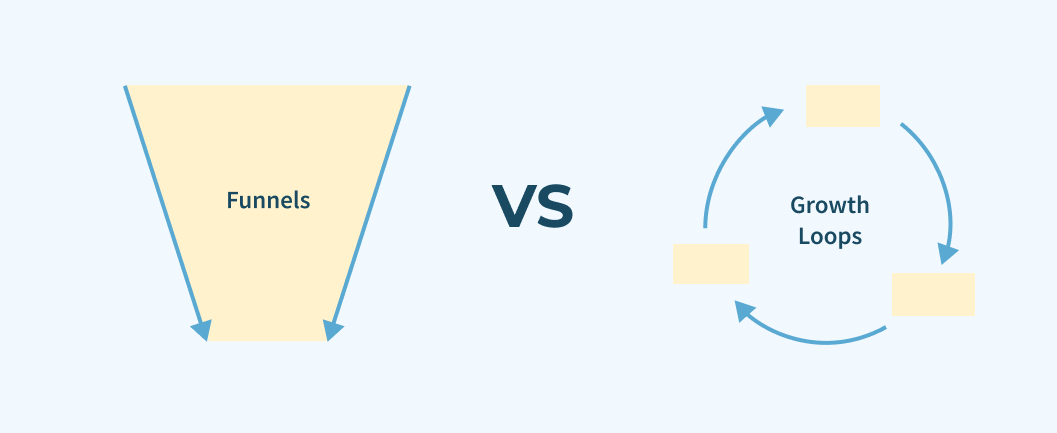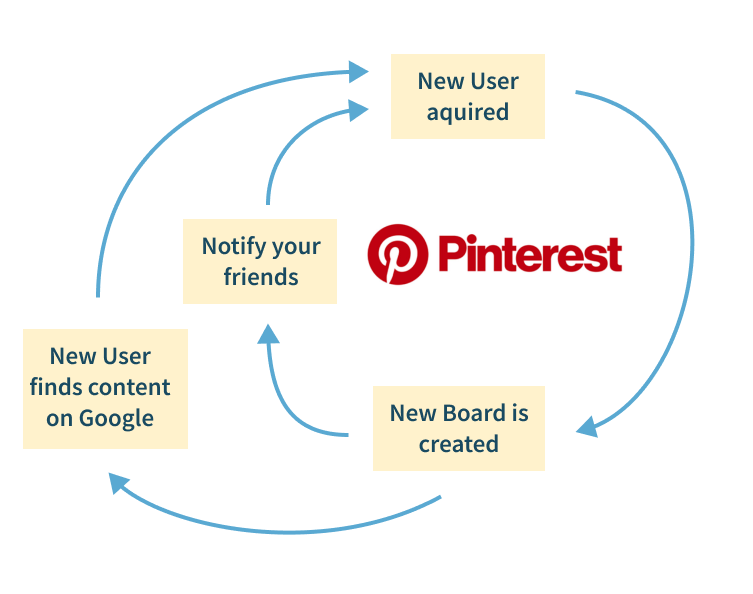What drives more growth?

When we started growth hacking, it was all about AARRR funnels, but as technology evolves and competition rises, funnels are no longer enough to drive growth.
While they remain necessary, loops emerged as a significant growth driver. Loops result in self-reinforcing growth.
Yet, too many businesses are still caught up in funnel thinking.
We can build a more robust growth engine by combining the power of funnels and growth loops. This article walks you through the evolution from marketing to funnels to loops.
From Marketing to Funnels
For many years, growth has been about optimizing the performance across the entire funnel. That was also the main difference between traditional marketing and growth.
Whilst marketing has always included ‘product’, it focuses more on the beginning of the funnel on how to acquire new customers and generate growth. Growth, in contrast, looks equally across the entire funnel to find growth opportunities.
Funnels, with their underlying growth methodologies, have proven superior over traditional marketing in four main areas:
1. Speed
Due to its agile cross-functional process, growth identifies and, more importantly, validates opportunities faster than traditional marketing. In addition, data-driven experiments outperform opinion-driven campaigns.
2. Efficiency
Using automation and creative ways of leveraging existing networks or traffic, called hacks, a full-funnel focus delivers more leads at a lower cost than marketing.
3. Effectiveness
Growth increases conversion by going beyond acquisition and optimizing the key moments that lead to purchase, thus increasing effectiveness. This makes Conversion Rate Optimization (CRO) a crucial part of growth hacking.
4. Going Viral
At the heart of growth often lies the desire to go viral. Famous examples are:
- A two-sided referral method such as Dropbox
- Self-serving tools such as HubSpot’s Website Grader
- Building referral into the product such as Hotmail’s signature in every email “PS: I love you. Get your free e-mail here at Hotmail.”
Funnels have been a successful method and status-quo in growth for a while.
Why funnels lost some appeal lately
But recent developments negatively impacted funnels and the focus on funnel methodology:
1. Overemphasis on lead generation
Funnels are an overly simplified version of reality. The focus has been on hacks and generating leads as efficiently and quickly as possible. Aside from referral loops, not much was happening after purchase to focus on growing after acquisition.
2. Competition has increased
What used to be a competitive advantage has become the standard playing field. As a result, having an optimized top of the funnel does not give you as much of a competitive advantage as it did a few years ago.
3. Paid acquisition costs have significantly increased
Using automation, some tactics can leverage relatively cheap customer acquisition costs through digital channels like Facebook or Google Display Ads. Yet, these costs have increased manifold, making “wide net” tactics unfeasible. Thus, it becomes more and more challenging to gain a strong ROI from existing marketing channels.
4. Most of all — limits in scalability due to a linear nature
The biggest argument why funnels are not the best way to generate growth is the linear nature of most channels. If you want more growth, you need to keep investing more resources. And the amount per acquisition increases as you reach scale due to diminished return effects.
The Returned Focus on Virality
Due to the diminished attractiveness of top-funnel tactics, viral growth returned into focus. And here, an evolution took place. For most, the focus for viral growth has been primarily on referral loops driven by triggering customers into action.
The loop-based growth is simple: I build an asset (and that can be a product) that delivers more customers with each customer who joins, thus creating an exponential growth curve. As a result, cost per acquisition decreases in contrast to linear channels.
Growth loops start slowly but allow for faster momentum in the long term.
Growth loops look at growth more holistically by focusing on how the product and business model can be used to create growth and retention, instead of simply pushing people further down the funnel.
There are two types of loops, product-based and non-product based loops. We start with the most common non-product based loops.
Non-Product Loops
There are three main types of non-product growth loops:
- Viral loops: Word of mouth drives more customers based on a non-monetary or monetary reward.
- Content loops: Content drives interest in the business and allows for more content to be created.
- Paid / Sales loop: Both paid advertising and sales representatives result in more customers, and that revenue is then reinvested in more ads or representatives.
Take Quora as an example; they have a content loop where the questions people ask get indexed, which drives more traffic and leads to more questions. Once they have the first questions on Quora and have got a strong domain ranking, the loop starts to go and drives their growth:
Whatever the loop type, the core of designing the loop is understanding which output will drive more input and the loop’s completion. Then the momentum results from a strong proposition: what drives value for the end-user at each step of the loop.
Most non-product loops are engagement-based. For example, viral (referral), content and sales are built around the product experience. Now we will look at how to use the product itself and its functionality to trigger loops.
Product Loops
The product is under the control of the company. If the use case allows for loops, it is easier to build them into the product than create them outside the product. This makes product-led growth appealing and fuels the popularity of the “Product-led growth” (PLG) movement.
PLG loops use the product itself to create further growth and usage. Here, loops are integrated into the product’s core functionality to drive re-engagement/retention or referral.
We talked about viral (referral) loops as a non-product led growth, but they can also be product-led. For example, if we look at Pinterest, a non-product referral loop would be telling your friend about Pinterest because you wanted to tell them about the tiles you saw there that would be perfect for your new bathroom. Here the referral happens outside the product.
In contrast, a product-led growth loop triggers users to share pins with friends as part of the product’s functionality within the platform itself. Each board post triggers new engagement. More engagement triggers more content. This combined with a content loop (where content gets found in Google) brings more users are brought into the platform (you need to sign up to see Pinterest content):

Pinterest has layered these two loops resulting in additional momentum. Most successful businesses have stacked multiple loops to increase the growth rate.
An example of a re-engagement loop is Slack, where a message triggers an email or browser notification that brings users back to the platform just in case you do not have the application open.

Here the built-in notifications help to keep users engaged and using the platform.
Bringing loops together into one model
Next to stacking loops on top of each other, as shown in the examples above, you can integrate them to create a multi-loop growth model. Take Amazon as an example:
Lower prices (at first) attract customers resulting in more traffic to the website. The growing customer base attracts more sellers. More sellers bring a wider selection of products which increases appeal to customers. Once it reaches a critical point, Amazon becomes the go-to supplier for most categories of goods. Their scale and innovation drive costs down, secure lower prices and keep the wheel spinning. You can see how once in motion, this multi-loop is self-perpetuating.
As long as customers think they get a good enough price for the convenience of Amazon, this flywheel will never stop. The combination of platform and category leadership has helped Amazon grow at its rate over the last few years.
Funnels vs Loops
Now that we discussed the evolution from marketing to funnels and the recent focus on loops, we want to discuss something we see among the growth community.
We are noticing that two camps have formed. The funnel camp and the product-led growth/loop camp.
It seems that ex-marketers tend to join the funnel camp whilst ex-product managers become a part of the PLG camp.
One group emphasizes efficient means to attract customers (the aforementioned hacks), while the others point to long-term scalability and costs.
Who is right in this opinion fight?
Both are right, and both are wrong.
We think it depends on your business model and your circumstances. For example, building product or business model-based loops is not feasible for some businesses, such as a once-in-a-lifetime purchase like an MBA degree or a B2B business with a very long sales cycle.
Not all businesses have the luxury to invest in building a non-product based loop either. Upfront costs of these asset-based growth generators can be high.
Others might have a loop, but that alone will not mean automatic success, for example, a 2-sided network or marketplace model of customer and supplier where there is the risk of the Cold Start Problem. For these businesses, linear channels should not be underestimated; e.g. a powerful channel like Public Relations can help start the product loop momentum.
Yet, we believe the factors limiting funnel-based growth are a serious obstacle to growth. Without some type of loop, it will be tough to scale your business.
Which brings us to our answer to: funnel or loops?
You need both.
It is the combination of funnels and loops that drives exceptional growth.
The exact model will depend on your business. However, the combination of the two allows you to kickstart your growth and turn this momentum into scalable and exponential growth.
The funnel fuels the acquisition loop until it exceeds the threshold of self-perpetuation. From this point on, the acquisition loop becomes the main driving factor of growth. A secondary retention loop prevents churn and further adds to the momentum of the acquisition loop.
The reality is, of course, more complex as you would put several loops in place, all reinforcing each other as much as possible, yet we want to bring the discussion of funnels versus loops to a new level by proposing this joint model.
Because we are growth hackers, we can not resist coining a new name for integrating funnel and loops: “Growth Foop”. Let’s see if it catches on.
